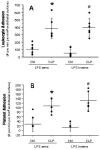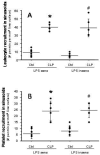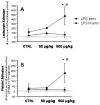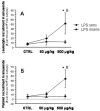Role of LPS in the hepatic microvascular dysfunction elicited by cecal ligation and puncture in mice
- PMID: 17935822
- PMCID: PMC2100413
- DOI: 10.1016/j.jhep.2007.07.021
Role of LPS in the hepatic microvascular dysfunction elicited by cecal ligation and puncture in mice
Abstract
Background/aims: Sepsis remains a leading cause of death in critically ill patients. Because endotoxemia is viewed as a key mediator of sepsis-induced inflammation, administration of bacterial endotoxin (LPS) is often used to simulate sepsis in experimental animals. This study tests the hypothesis that LPS is a critical determinant of the hepatic microvascular dysfunction in mice made septic by cecal ligation and puncture (CLP).
Methods: Intravital videomicroscopy was used to quantify sinusoidal perfusion, and platelet and leukocyte adhesion in terminal hepatic venules (THV) and sinusoids in LPS-sensitive and LPS-insensitive mice subjected to CLP or LPS (i.p.). mRNA expression of TLR-2, TLR-4, MyD-88, and Ly-96 was also assessed.
Results: While LPS-sensitive mice responded to both CLP and LPS challenges with elevated leukocyte and platelet adhesion in THV and sinusoids, and a reduced sinusoidal perfusion density, LPS-insensitive mice exhibited comparable blood cell adhesion and sinusoidal malperfusion following CLP, but not LPS. Hepatic mRNA of MyD-88 and TLR-2 was elevated in the CLP and LPS groups. Endotoxin was not detectable in the blood of LPS-sensitive mice after CLP, but was elevated after LPS administration.
Conclusions: These findings do not support a major role for LPS in the hepatic microvascular disturbances associated with polymicrobial sepsis.
Figures







Comment in
-
Hepatic microvascular dysfunction and endotoxemia in sepsis.J Hepatol. 2008 Apr;48(4):676; author reply 677. doi: 10.1016/j.jhep.2008.01.003. Epub 2008 Jan 28. J Hepatol. 2008. PMID: 18276030 No abstract available.
Similar articles
-
Platelet recruitment in the murine hepatic microvasculature during experimental sepsis: role of neutrophils.Microcirculation. 2006 Mar;13(2):89-97. doi: 10.1080/10739680500466343. Microcirculation. 2006. PMID: 16459322
-
Hepatic microcirculation in murine sepsis: role of lymphocytes.Pediatr Surg Int. 2008 Jan;24(1):13-20. doi: 10.1007/s00383-007-2037-0. Pediatr Surg Int. 2008. PMID: 17955248
-
Reactive oxygen and nitrogen species in sepsis-induced hepatic microvascular dysfunction.Inflamm Res. 2013 Feb;62(2):155-64. doi: 10.1007/s00011-012-0562-3. Epub 2012 Oct 18. Inflamm Res. 2013. PMID: 23076073 Free PMC article.
-
The changes of hepatic sinusoidal microcirculation and effects of nitric oxide synthase inhibitor during sepsis.Hepatogastroenterology. 2003 Jan-Feb;50(49):213-6. Hepatogastroenterology. 2003. PMID: 12630025
-
Potentiated hepatic microcirculatory response to endothelin-1 during polymicrobial sepsis.Shock. 2002 Nov;18(5):415-22. doi: 10.1097/00024382-200211000-00005. Shock. 2002. PMID: 12412619
Cited by
-
Vascular Endothelial Cells and Innate Immunity.Arterioscler Thromb Vasc Biol. 2020 Jun;40(6):e138-e152. doi: 10.1161/ATVBAHA.120.314330. Epub 2020 May 27. Arterioscler Thromb Vasc Biol. 2020. PMID: 32459541 Free PMC article. Review.
-
An evolving new paradigm: endothelial cells--conditional innate immune cells.J Hematol Oncol. 2013 Aug 22;6:61. doi: 10.1186/1756-8722-6-61. J Hematol Oncol. 2013. PMID: 23965413 Free PMC article. Review.
-
Advances in Rodent Experimental Models of Sepsis.Int J Mol Sci. 2023 May 31;24(11):9578. doi: 10.3390/ijms24119578. Int J Mol Sci. 2023. PMID: 37298529 Free PMC article. Review.
-
Polymicrobial sepsis and endotoxemia promote microvascular thrombosis via distinct mechanisms.J Thromb Haemost. 2010 Jun;8(6):1403-9. doi: 10.1111/j.1538-7836.2010.03853.x. Epub 2010 Mar 12. J Thromb Haemost. 2010. PMID: 20345726 Free PMC article.
-
Western diet enhances hepatic inflammation in mice exposed to cecal ligation and puncture.BMC Physiol. 2010 Oct 19;10:20. doi: 10.1186/1472-6793-10-20. BMC Physiol. 2010. PMID: 20958969 Free PMC article.
References
-
- Angus DC, Linde-Zwirble WT, Lidicker J, Clermont G, Carcillo J, Pinsky MR. Epidemiology of severe sepsis in the United States: analysis of incidence, outcome, and associated costs of care. Crit Care Med. 2001;29:1303–1310. - PubMed
-
- Fry DE, Pearlstein L, Fulton RL, Polk HC., Jr Multiple system organ failure. The role of uncontrolled infection. Arch Surg. 1980;115:136–140. - PubMed
-
- Beal AL, Cerra FB. Multiple organ failure syndrome in the 1990s. Systemic inflammatory response and organ dysfunction. Jama. 1994;271:226–233. - PubMed
-
- Eipel C, Bordel R, Nickels RM, Menger MD, Vollmar B. Impact of leukocytes and platelets in mediating hepatocyte apoptosis in a rat model of systemic endotoxemia. Am J Physiol Gastrointest Liver Physiol. 2004;286:G769–G776. - PubMed
-
- Salkowski CA, Detore G, Franks A, Falk MC, Vogel SN. Pulmonary and hepatic gene expression following cecal ligation and puncture: monophosphoryl lipid A prophylaxis attenuates sepsis-induced cytokine and chemokine expression and neutrophil infiltration. Infect Immun. 1998;66:3569–3578. - PMC - PubMed
Publication types
MeSH terms
Substances
Grants and funding
LinkOut - more resources
Full Text Sources
Medical
Miscellaneous

